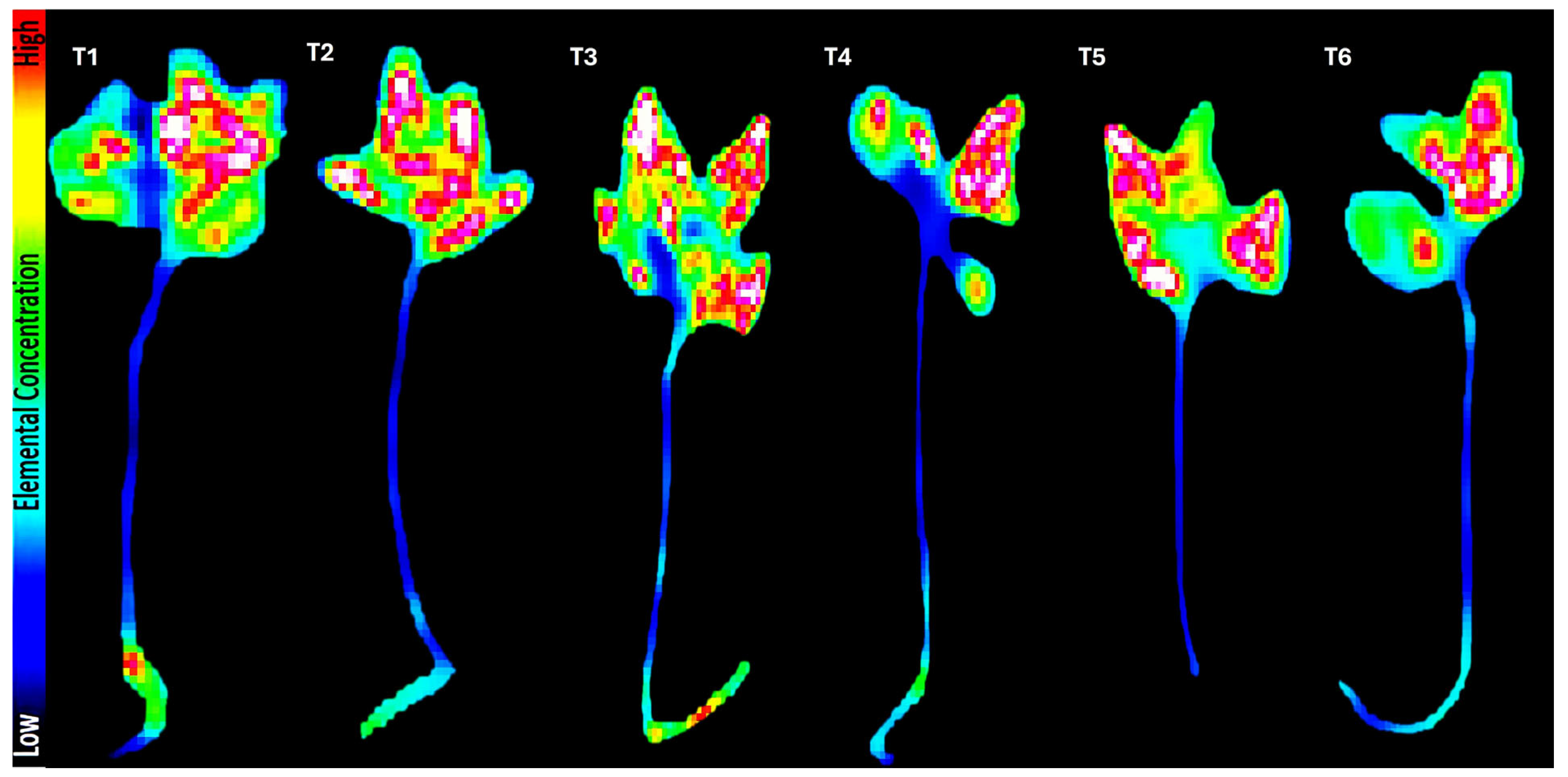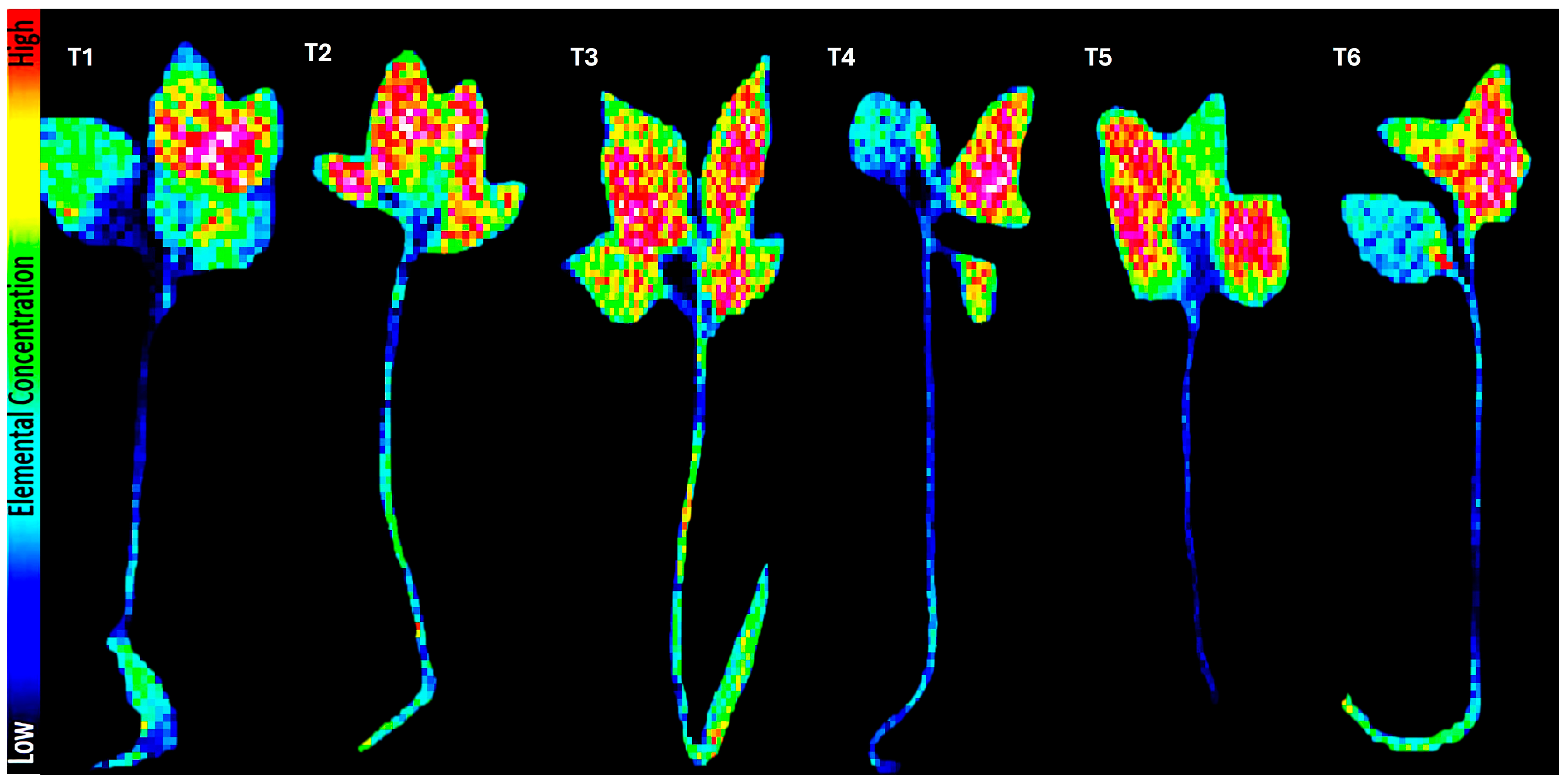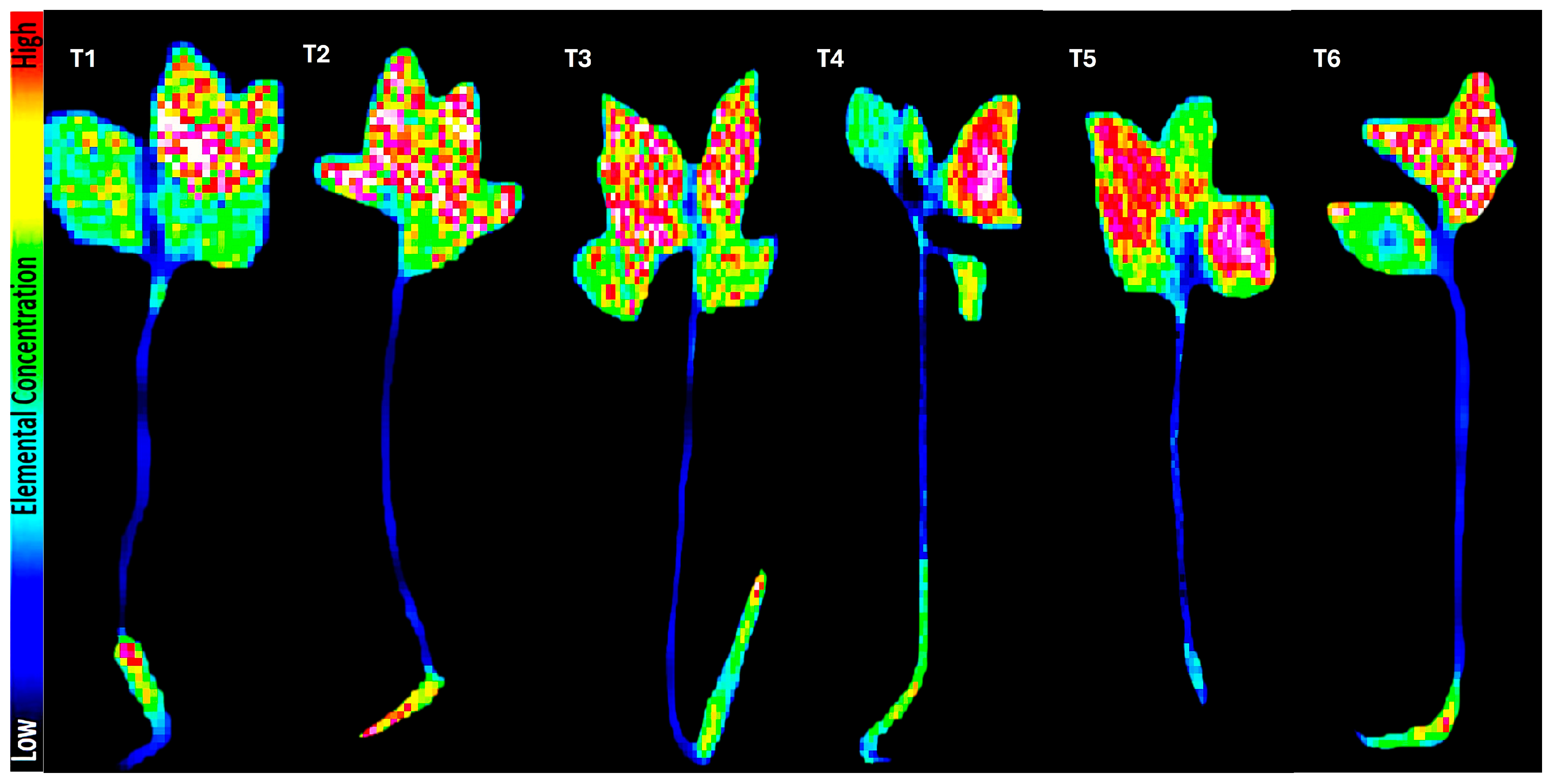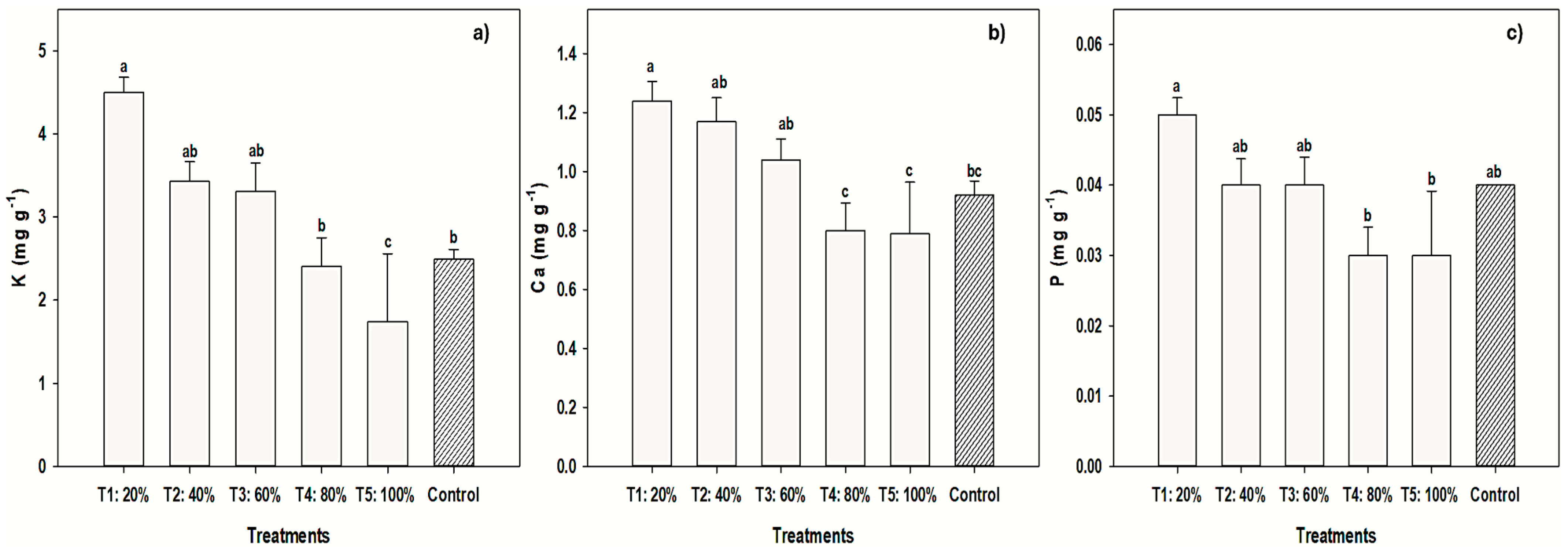Impact of Treated Swine Wastewater on Elemental Distribution in the Growth of Habanero Pepper Seedlings
Abstract
1. Introduction
2. Materials and Methods
2.1. Study Site
2.2. Swine Wastewater Collection and Characterization
2.3. Experimental Design and Plant Material
2.4. Evaluated Variables
2.5. Emergence Test and Emergence Rate Index
2.6. Evaluation of the Morphological Traits of the Seedlings
2.7. Elemental Analysis of Seedlings
2.8. Statistical Analysis
3. Results
3.1. Physicochemical Parameters of Swine Wastewater
3.2. Seedling Emergence and the Emergence Rate
3.3. Distribution and Concentration of Essential and Non-Essential Elements in Habanero Pepper Seedlings
3.4. Morphological Characteristics in Habanero Pepper Seedlings
4. Discussion
4.1. Swine Wastewater
4.2. Physiological Responses of Habanero Pepper Seeds
4.3. Distribution and Concentration of Essential Elements in Habanero Pepper Seedlings
4.4. Morphological Responses of Habanero Chile Seedlings Irrigated with Pig Wastewater
5. Conclusions
Author Contributions
Funding
Data Availability Statement
Acknowledgments
Conflicts of Interest
References
- SIAP-SADER. Producción Pecuaria de México. Servicio de Información Agropecuaria, Secretaria de Agricultura Y Desarrollo Rural. México. 2019. Available online: https://www.inforural.com.mx/produccionpecuaria-de-mexico/ (accessed on 13 April 2025).
- Bautista, F.; Aguilar, Y.; Díaz, E.; Cano, A.; Ramírez, S. Los Territorios Kársticos de la Península de Yucatán: Caracterización, Manejo Y Riesgos. Asociación Mexicana de Estudios Sobre El Karst. Ciudad de México. Los Suelos Como Plantas de Tratamiento de Las Aguas Residuales Porcinas. 2021. Available online: https://www.researchgate.net/publication/352750661 (accessed on 13 April 2025).
- Bautista, F.; Aguilar, Y.; Gijón-Yescas, N. Las granjas porcinas en zonas de karst: ¿Cómo pasamos de la contaminación a la sustentabilidad? Trop. Subtrop. Agroecosystems 2022, 25, #093. [Google Scholar] [CrossRef]
- Kesari, K.K.; Soni, R.; Jamal, Q.M.S. Wastewater Treatment and Reuse: A Review of its Applications and Health Implications. Water Air Soil Pollut. 2021, 232, 208. [Google Scholar] [CrossRef]
- Hussein, E.A.; Mohammadi, A.; Hejna, A.; Majtacz, J.; Esmaeili, A.; Habibzadeh, S.; Reza-Saeb, M.; Badawi, M.; Lima, E.; Mąkinia, J. Wastewater reuse in agriculture: Prospects and challenges. Environ. Res. 2023, 236, 1. [Google Scholar] [CrossRef]
- Valdez-Vázquez, M.; Bobadilla-Vidrio, Y.G.; García-Reyes, R.B.; Martínez-Rodríguez, C.M.; Alvarez-Valencia, L.H. Influencia de la separación de agua residual porcina en fracciones sólida y líquida, en la producción de metano con Iodo anaerobio granular y disperso. Biotecnia 2022, 24, 107–115. [Google Scholar] [CrossRef]
- Mendoza-Retana, S.S.; Cervantes-Vázquez, M.G.; Valenzuela-Garcia, A.A.; Guzmán-Silos, T.L.; Orona-Castillo, I.; Cervantes-Vázquez, T.J. Uso potencial de las aguas residuales en la agricultura. Rev. Mex. De Cienc. Agrícolas 2021, 12, 115–126. [Google Scholar] [CrossRef]
- Pérez-Gutiérrez, A.; Dzul-Mukul, C.R.; Borges-Gómez, L.; Latournerie-Moreno, L.; Ruiz-Sánchez, E.; Ayora-Ricalde, G. Potential use of pork farm effluents for Capsicum chinense production. Rev. Fitotec. Mex. 2015, 38, 383–387. [Google Scholar]
- Caballero-Salinas, J.C.; Ovando-Salinas, S.G.; Núñez-Ramos, E.; Aguilar-Cruz, F. Sustratos alternativos para la producción de plántulas de tomate de cáscara (Physalis ixocarpa Brot.) en Chiapas. Rev. Siembra 2020, 7, 14–21. [Google Scholar] [CrossRef]
- Mergen Junior, C.A.; Loss, A.; Dos Santos Junior, E.; Dupont Giumbelli, L.; De Pinho, D.; De Abreu, L.; Rogério Lourenzini, C.; Comín, J.J.; Brunetto, G. Caracterización física de agregados de suelo sometido a 10 años de aplicación de efluentes porcinos. Artículo de investigación: Ciencias del suelo. Rev. De Cienc. Agrícolas 2019, 36, 79–92. [Google Scholar] [CrossRef]
- Durukan, H.; Demirbas, A.; Tutar, U. The effects of solid and liquid vermicompost application on yield and nutrient uptake of tomato plant. Turk. J. Agric.-Food Sci. Technol. 2019, 7, 1069–1074. Available online: https://agrifoodscience.com/index.php/TURJAF/article/view/2579 (accessed on 13 April 2025).
- Torres-García, A.; Héctor-Ardisana, E.F.; Fosado-Téllez, O.; Cué-García, J.L.; Mero-Muñoz, J.A.; León-Aguilar, R.; Peñarrieta-Bravo, S. Respuesta del pimiento (Capsicum annuum L.) ante aplicaciones foliares de diferentes dosis y fuentes de lixiviados de vermicompost. Bioagro 2019, 31, 213–220. [Google Scholar]
- WWAP. Programa Mundial de Evaluación de los Recursos Hídricos, Informe mundial de las Naciones Unidas sobre el desarrollo de los recursos hídricos. 2017. In Aguas Residuales: El Recurso No Explotado; Unesco: París, France, 2017. [Google Scholar]
- Drechsel, P.; Marjani-Zadeh, S.; Pedrero, F. Water Quality in Agriculture: Risks and Risk Mitigation; FAO & IWMI: Rome, Italy, 2023. [Google Scholar]
- Knechtel, R.J. A more economical method for the determination of chemical oxygen demand. Water Pollut. Control 1978, 25–29. [Google Scholar]
- Hernández-Pinto, C.; Garruña, R.; Andueza-Noh, R.; Hernández-Núñez, E.; Zavala-León, M.J.; Pérez-Gutiérrez, A. Post-harvest storage of fruits: An alternative to improve physiological quality in habanero pepper seeds. Rev. Bio Cienc. 2020, 7, e796. [Google Scholar] [CrossRef]
- Dickson, A.; Leaf, A.L.; Hosner, J.F. Quality appraisal of white spruce and white pine seedlings stock in nurseries. For. Chron. 1960, 36, 10–13. [Google Scholar] [CrossRef]
- Cárdenas, M.; Espinosa, S.; Cárdenas, M. Determinación de parámetros del agua residual de una granja porcina en el municipio Torbes, Táchira. Rev. Científica Unet. Cienc. Exactas 2017, 29, 161–172. [Google Scholar]
- Bilal, H.M.; Zulfiqar, R.; Adnan, M.; Umer, M.S.; Islam, H.; Zaheer, H.; Abbas, W.M.; Haider, F.; Ahmad, I. Impact of salinity on citrus production; A review. Int. J. Appl. Res. 2020, 6, 173–176. [Google Scholar]
- Mahfooz, Y.; Yasar, A.; Guijian, L.; Islam, Q.U.; Akhtar, A.B.T.; Rasheed, R.; Irshad, S.; Naeem, U. Critical risk analysis of metal toxicity in soil and crops irrigated with wastewater: A study from a semi-arid developing region. Sci. Rep. 2020, 10, 12845. [Google Scholar] [CrossRef]
- Gamboa-Angulo, J.; Ruíz-Sánchez, E.; Alvarado-López, C.; Gutiérrez-Miceli, F.; Ruíz-Valdiviezo, V.M.; Medina-Dzul, K. Efecto de biofertilizantes microbianos en las características agronómicas de la planta y calidad del fruto del chile xcat´ik (Capsicum annuum L.). Terra Latinoam. 2020, 38, 817–826. [Google Scholar] [CrossRef]
- Hernández-Pinto, C.D.; Alvarado-López, C.J.; Garruña, R.; Andueza-Noh, R.H.; Hernández-Núñez, E.; Zamora-Bustillos, R.; Ballina-Gómez, H.S.; Ruiz-Sánchez, E.; Samaniego-Gámez, B.Y.; Samaniego-Gámez, S.U. Kinetics of Macro and Micronutrients during Germination of Habanero Pepper Seeds in Response to Imbibition. Agronomy 2022, 12, 2117. [Google Scholar] [CrossRef]
- Cedeño-Guerra, J.L.; Héctor-Ardisana, E.F.; Torres-García, A.; Fosado-Téllez, O. Respuestas del crecimiento y el rendimiento en pimiento (Capsicum annuum L.) híbrido Nathalie a un lixiviado de vermicompost bovino. Técnica Rev. Agrocienc. 2020, 2, 1–10. [Google Scholar] [CrossRef]
- Luna-Fletes, J.A.; Cruz-Crespo, E.; Can-Chulim, A.; Chan-Cupul, W.; Luna-Esquivel, G.; García-Paredes, J.D.; Mancilla-Villa, O.R. Producción de plántulas de chile habanero con fertilización orgánica y biológica. Terra Latinoam. 2022, 39, e988. [Google Scholar] [CrossRef]
- Calero-Hurtado, A.; Pérez Díaz, Y.; González-Pardo, H.Y.; Yanes-Simón, L.A.; Peña-Calzada, K.; Olivera-Viciedo, D.; Meléndrez-Rodríguez, J.F. Respuesta agroproductiva de la habichuela a la aplicación de vermicompost lixiviado y microorganismos eficientes. Rev. De La Fac. de Ciencias 2020, 9, 112–124. [Google Scholar] [CrossRef]
- Yoon, H.; Kang, Y.G.; Chang, Y.; Seok-Kim, J.H. Effects of Zerovalent Iron Nanoparticles on Photosynthesis and Biochemical Adaptation of Soil-Grown Arabidopsis thaliana. Nanomaterials 2019, 9, 1543. [Google Scholar] [CrossRef] [PubMed]
- Gohain, B.P.; Rose, T.J.; Liu, L.; Barkla, B.J.; Raymond, C.A.; King, G.J. Remobilization and fate of sulphur in mustard. Ann. Bot. 2019, 124, 471–480. [Google Scholar] [CrossRef]
- Garcia-Terrazas, M.I.; Santillán-Carrillo, I.E.; Holguín-Mina, R.; Sariñana-Aldaco, O. Impacto de la conductividad eléctrica de la solución nutritiva en la biomasa, pigmentos fotosintéticos y compuestos nitrogenados en lechuga. Biotecnia 2022, 24, 115–122. [Google Scholar] [CrossRef]
- Cázarez-Flores, L.L.; Partida-Ruvalcaba, L.; Velázquez-Alcaraz, T.J.; Ayala-Tafoya, F.; Díaz-Valdés, T.; Yáñez-Juárez, M.G.; López-Orona, C.A. Silicio y cloro en el crecimiento, rendimiento y calidad postcosecha de pepino y tomate. Terra Latinoam. 2022, 40, e994. [Google Scholar] [CrossRef]
- Su, L.; Lu, T.; Li, Q.; Li, Y.; Wan, X.; Jiang, W.; Yu, H. Chlorine Modulates Photosynthetic Efficiency, Chlorophyll Fluorescence in Tomato Leaves, and Carbohydrate Allocation in Developing Fruits. Int. J. Mol. Sci. 2025, 26, 2922. [Google Scholar] [CrossRef] [PubMed]
- Franco-Navarro, J.D.; Díaz-Rueda, P.; Rivero-Núñez, C.M.; Brumós, J.; Rubio-Casal, A.E.; De Cires, A.; Colmenero-Flores, J.M.; Rosales, M.A. Chloride nutrition improves drought resistance by enhancing water deficit prevention and tolerance mechanisms. J. Exp. Bot. 2021, 72, 5246–5261. [Google Scholar] [CrossRef]
- Geilfus, C.M. Review on the significance of chlorine for crop yield and quality. Plant Sci. 2018, 270, 114–122. [Google Scholar] [CrossRef]
- Jobe, T.O.; Zenzen, I.; Rahimzadeh-Karvansara, P.; Kopriva, S. Integration of sulfate assimilation with carbon and nitrogen metabolism in transition from C3 to C4 photosynthesis. J. Exp. Bot. 2019, 70, 4211–4221. [Google Scholar] [CrossRef]
- Ungureanu, N.; Vlăduț, V.; Voicu, G. Water scarcity and wastewater reuse for crop irrigation. Sustainability 2020, 12, 9055. [Google Scholar] [CrossRef]
- Chinga, W.; Torres-García, A.; Chirinos, D.T.; Marmol, L.E. Efecto de un lixiviado de vermicompost sobre el crecimiento y producción del algodón. Rev. Científica Ecuat. 2020, 7, 32–40. [Google Scholar] [CrossRef]
- Acevedo-Alcalá, P.; Cruz-Hernández, J.; Taboada-Gaytán, O.R. Abonos orgánicos comerciales, estiércoles locales y fertilización química en la producción de plántula de chile poblano. Rev. Fitotec. Mex. 2020, 43, 35–44. [Google Scholar] [CrossRef]
- Poustie, A.; Yang, Y.; Verburg, P.; Pagilla, K.; Hanigan, D. Reclaimed wastewater as a viable water source for agricultural irrigation: A review of crop growth inhibition and promotion in the context of environmental change. Cienc. Medio Ambiente Total 2020, 739, 139756. [Google Scholar] [CrossRef] [PubMed]
- Chaoua, S.; Boussaa, S.; El Gharmali, A.; Boumezzough, A. Impact of irrigation with wastewater on the accumulation of heavy metals in soil and crops in the Marrakech region of Morocco. Saudi J. Biol. Sci. 2019, 18, 429–436. [Google Scholar] [CrossRef]
- Mehmood, A.; Mirza, A.S.; Choudhary, M.A.; Kim, K.H.; Raza, W.; Raza, N.; Lee, S.S.; Zhang, M.; Lee, J.H.; Sarfraz, M. Spatial distribution of heavy metals in crops from a wastewater-irrigated area and associated health risk assessment. Environ. Res. 2019, 168, 382–388. [Google Scholar] [CrossRef]
- Njuguna, S.M.; Makokha, V.A.; Yan, X.; Gituru, R.W.; Wang, Q.; Wang, J. Health risk assessment through consumption of vegetables irrigated with reclaimed wastewater: A case study of Thika, Kenya. J. Environ. Manag. 2019, 231, 576–581. [Google Scholar] [CrossRef]







| Treatments | pH | EC (µS/cm) | COD (mg/L) | TKN (mg/L) | TP (mg/L) |
|---|---|---|---|---|---|
| T1: 20% wastewater + 80% water | 7.53 NS | 2120 ± 0.11 e | 144 ± 0.17 d | 136 ± 0.2 e | 11.2 ± 0.12 a |
| T2: 40% wastewater + 60% water | 8.55 NS | 3437 ± 0.13 d | 201 ± 0.22 c | 247± 0.3 d | 9.80 ± 0.15 a |
| T3: 60% wastewater + 40% water | 8.7 NS | 4612 ± 0.17 c | 290 ± 0.27 b | 422 ± 0.33 c | 8.11 ± 0.21 b |
| T4: 80% wastewater + 20% water | 8.91 NS | 5700 ± 0.24 ab | 485 ± 0.41 a | 571 ± 0.52 b | 5.34 ± 0.33 c |
| T5: 100% wastewater | 9.20 NS | 7233 ± 0.31 a | 563 ± 0.55 a | 711 ± 0.74 a | 6.63 ± 0.38 c |
| T6: 100% water (control) | 7.0 NS | 878 ± 0.034 f | 5 ± 0.01 e | 5.8 ± 0.1 f | 6.0 ± 0.09 c |
| p-value | 0.1781 | 0.0199 | 0.0398 | 0.0297 | 0.0241 |
| Treatments | Seedling Emergence (%) | Emergence Rate (Seedling/Day) |
|---|---|---|
| T1: 20% wastewater + 80% water | 97 ± 0.06 a | 13.09 ± 0.01 a |
| T2: 40% wastewater + 60% water | 87 ± 0.05 ab | 9 ± 0.03 b |
| T3: 60% wastewater + 40% water | 81 ± 0.06 bc | 5.1 ± 0.01 c |
| T4: 80% wastewater + 20% water | 78 ± 0.87 bc | 3.77 ± 1.04 c |
| T5: 100% wastewater | 70 ± 2.0 c | 3.10 ± 1.51 c |
| T6: 100% water (control) | 98 ± 0.03 a | 13.58 ± 0.01 a |
| p-value | 0.0020 | 0.0056 |
| Treatments | C/N | Height (cm) | Stem Dry Weight (mg) | Root Dry Weight (mg) | Total Dry Weight (mg) | Slenderness Index | Dickson Quality Index |
|---|---|---|---|---|---|---|---|
| T1: 20% wastewater + 80% water | 3.75 ± 0.09 b | 8.11 ± 0.06 a | 130.94 ± 0.003 a | 41.83 ± 0.001 a | 172.77 ± 0.003 a | 4.26 ± 0.04 a | 0.23 ± 0.001 a |
| T2: 40% wastewater + 60% water | 3.90 ± 0.14 b | 7.25 ± 0.08 bc | 107.63 ± 0.004 b | 26.39 ± 0.002 b | 134.02± 0.004 b | 3.77 ± 0.05 b | 0.15 ± 0.005 b |
| T3: 60% wastewater + 40% water | 3.97 ± 0.22 ab | 6.68 ± 0.08 c | 105.18 ± 0.005 b | 30.43 ± 0.003 b | 135.63 ± 0.003 b | 3.73 ± 0.06 b | 0.19 ± 0.06 ab |
| T4: 80% wastewater + 20% water | 4.07 ± 0.30 a | 6.46 ± 0.10 c | 96 ± 0.007 b | 22.87 ± 0.003 b | 118.87 ± 0.006 b | 3.59 ± 0.08 b | 0.017 ± 0.09 b |
| T5: 100% wastewater | 4.20 ± 0.55 a | 3.31 ± 0.32 d | 58.84 ± 0.006 c | 6.85 ± 0.010 c | 65.69 ± 0.008 c | 2.69 ± 0.24 c | 0.05 ± 0.11 c |
| T6: 100% water (control) | 3.40 ± 0.01 c | 7.87 ± 0.05 a | 112.51 ± 0.002 ab | 41.85± 0.001 a | 154.36 ± 0.003 ab | 3.85 ± 0.05 ab | 0.22 ± 0.001 a |
| p-value | 0.0421 | 0.0362 | 0.0237 | 0.0473 | 0.0197 | 0.0234 | 0.0452 |
Disclaimer/Publisher’s Note: The statements, opinions and data contained in all publications are solely those of the individual author(s) and contributor(s) and not of MDPI and/or the editor(s). MDPI and/or the editor(s) disclaim responsibility for any injury to people or property resulting from any ideas, methods, instructions or products referred to in the content. |
© 2025 by the authors. Licensee MDPI, Basel, Switzerland. This article is an open access article distributed under the terms and conditions of the Creative Commons Attribution (CC BY) license (https://creativecommons.org/licenses/by/4.0/).
Share and Cite
Hernández-Pinto, C.D.; Vega-De-Lille, M.I.-c.; Giácoman-Vallejos, G.; Ponce-Caballero, C.; Quintal-Franco, C.A.; Méndez-Novelo, R.I.; Alvarado-López, C.J.; Hernández-Núñez, E. Impact of Treated Swine Wastewater on Elemental Distribution in the Growth of Habanero Pepper Seedlings. Agronomy 2025, 15, 1473. https://doi.org/10.3390/agronomy15061473
Hernández-Pinto CD, Vega-De-Lille MI-c, Giácoman-Vallejos G, Ponce-Caballero C, Quintal-Franco CA, Méndez-Novelo RI, Alvarado-López CJ, Hernández-Núñez E. Impact of Treated Swine Wastewater on Elemental Distribution in the Growth of Habanero Pepper Seedlings. Agronomy. 2025; 15(6):1473. https://doi.org/10.3390/agronomy15061473
Chicago/Turabian StyleHernández-Pinto, Carlos David, Marisela Ix-chel Vega-De-Lille, Germán Giácoman-Vallejos, Carmen Ponce-Caballero, Calos Alberto Quintal-Franco, Roger Iván Méndez-Novelo, Carlos Juan Alvarado-López, and Emanuel Hernández-Núñez. 2025. "Impact of Treated Swine Wastewater on Elemental Distribution in the Growth of Habanero Pepper Seedlings" Agronomy 15, no. 6: 1473. https://doi.org/10.3390/agronomy15061473
APA StyleHernández-Pinto, C. D., Vega-De-Lille, M. I.-c., Giácoman-Vallejos, G., Ponce-Caballero, C., Quintal-Franco, C. A., Méndez-Novelo, R. I., Alvarado-López, C. J., & Hernández-Núñez, E. (2025). Impact of Treated Swine Wastewater on Elemental Distribution in the Growth of Habanero Pepper Seedlings. Agronomy, 15(6), 1473. https://doi.org/10.3390/agronomy15061473








